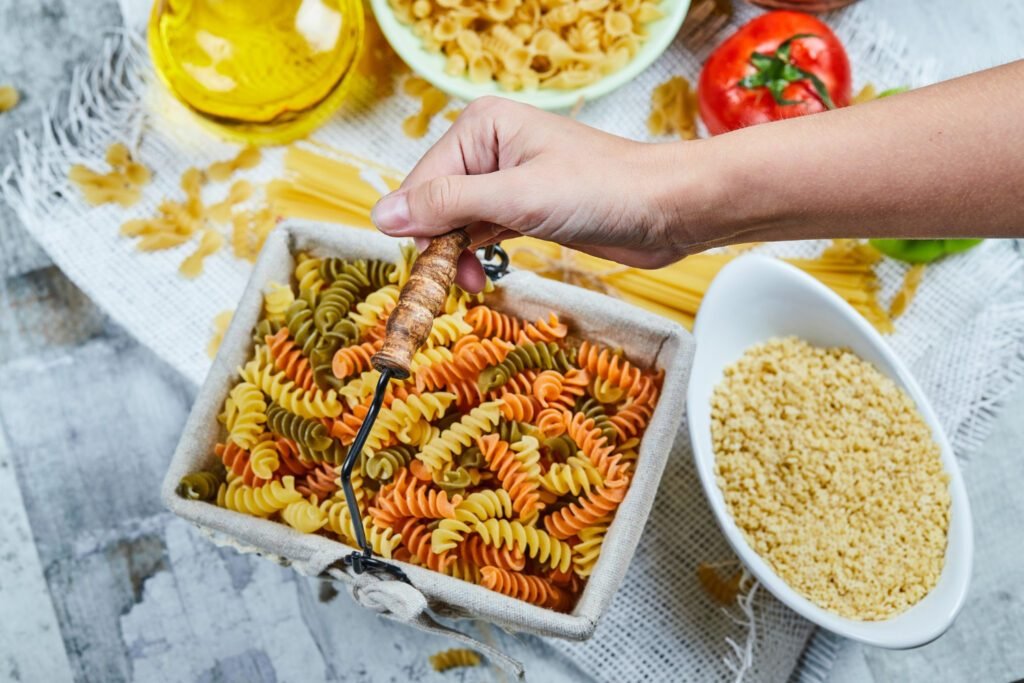Making pasta from scratch is a rewarding and fun culinary adventure. Whether you’re aiming for silky-smooth tagliatelle, robust fettuccine, or delicate ravioli, homemade pasta offers a taste and texture that store-bought versions just can’t match. Let’s dive into the step-by-step process to help you make pasta like a pro!
Tools and Ingredients You’ll Need
Tools:
- Large mixing bowl
- Measuring cups and spoons
- Digital scale (optional but recommended)
- Fork or whisk
- Rolling pin or pasta machine
- Bench scraper or knife
- Clean kitchen towel
- Pasta drying rack (optional)
Ingredients:
- 2 cups (240g) all-purpose flour, plus extra for dusting
- 3 large eggs
- 1/2 teaspoon salt
- 1 tablespoon olive oil (optional)
Step-by-Step Guide to Making Pasta Dough
- Measure and Prepare:
- Measure out your flour and create a mound on a clean work surface. Make a well in the center.
- Add Eggs and Salt:
- Crack the eggs into the well and add the salt. If using olive oil, add it here.
- Mixing the Dough:
- Using a fork or whisk, gradually incorporate the flour into the eggs. Once the mixture starts to come together, use your hands to form a dough.
- Kneading:
- Knead the dough for about 10 minutes until it becomes smooth and elastic. If the dough is too sticky, add a little more flour. If it’s too dry, add a few drops of water.
- Resting:
- Wrap the dough in plastic wrap or cover it with a clean kitchen towel and let it rest for at least 30 minutes. This allows the gluten to relax and makes rolling easier.
Rolling and Shaping the Pasta
- Divide the Dough:
- Cut the dough into 4 equal pieces. Work with one piece at a time, keeping the others covered.
- Rolling Out:
- Flatten the dough piece into a rough rectangle with your hands. Using a rolling pin or a pasta machine, roll the dough to your desired thickness. If using a pasta machine, start on the widest setting and gradually work down to thinner settings.
- Cutting the Pasta:
- For tagliatelle or fettuccine, roll the dough into a loose log and cut into strips. For lasagna, cut into long sheets. For ravioli, place fillings on one sheet, cover with another, and cut into squares.
- Drying (Optional):
- If you’re not cooking the pasta immediately, hang the strips on a pasta drying rack or lay them out on a floured surface to dry for 30 minutes.
Cooking Your Homemade Pasta
- Boil Water:
- Bring a large pot of salted water to a rolling boil.
- Cook the Pasta:
- Fresh pasta cooks quickly – usually 2-3 minutes. Test for doneness and drain when al dente.
- Serve Immediately:
- Toss the pasta with your favorite sauce and serve immediately for the best texture and flavor.
Tips for Perfect Pasta
- Use Quality Ingredients: Fresh, high-quality eggs and flour make a noticeable difference in taste and texture.
- Keep the Dough Moist: Avoid adding too much flour while kneading to keep the dough from drying out.
- Consistent Thickness: Roll the dough to an even thickness to ensure uniform cooking.
- Experiment with Flavors: Add finely chopped herbs, spinach, or tomato paste to the dough for colored and flavored pasta.
Common Issues and Solutions
- Dough is Too Sticky: Add flour a little at a time while kneading until the dough is smooth and not sticky.
- Dough is Too Dry: Add water drop by drop and knead until the dough comes together.
- Pasta Sticks Together: Ensure the pasta is well-floured when cutting and drying, and use plenty of boiling water to cook.
Delicious Pasta Recipes to Try
- Classic Tagliatelle with Bolognese:
- Ingredients: Homemade tagliatelle, ground beef, tomato sauce, onions, carrots, celery, garlic, red wine, and Italian herbs.
- Method: Cook the Bolognese sauce slowly to develop flavors, then toss with fresh tagliatelle.
- Spinach and Ricotta Ravioli:
- Ingredients: Homemade pasta sheets, fresh spinach, ricotta cheese, Parmesan cheese, egg, salt, and pepper.
- Method: Fill pasta sheets with spinach and ricotta mixture, cut into ravioli, and cook until tender. Serve with sage butter sauce.
- Fettuccine Alfredo:
- Ingredients: Homemade fettuccine, heavy cream, butter, garlic, Parmesan cheese, salt, and pepper.
- Method: Prepare Alfredo sauce by combining butter, cream, and cheese, then toss with cooked fettuccine.
FAQs
Q: Can I make pasta without a pasta machine? A: Absolutely! While a pasta machine makes the process easier, you can achieve great results with a rolling pin. Just be prepared to put in a bit more effort to roll the dough thinly and evenly.
Q: How do I store fresh pasta? A: Fresh pasta can be stored in the fridge for up to two days. To store longer, let it dry completely and then freeze it in airtight containers for up to a month.
Q: Can I use whole wheat flour instead of all-purpose flour? A: Yes, but whole wheat flour will create a denser, nuttier pasta. You might need to adjust the water content slightly to get the right dough consistency.
Q: Why did my pasta turn out chewy? A: Over-kneading or not resting the dough can lead to chewy pasta. Ensure you knead just until smooth and elastic and let the dough rest adequately.
Final Thoughts
Making pasta from scratch is a fulfilling and enjoyable experience that brings a touch of authenticity to your kitchen. With a bit of practice and patience, you’ll soon be crafting pasta that rivals any Italian restaurant. So, gather your ingredients, roll up your sleeves, and start making pasta like a pro!

